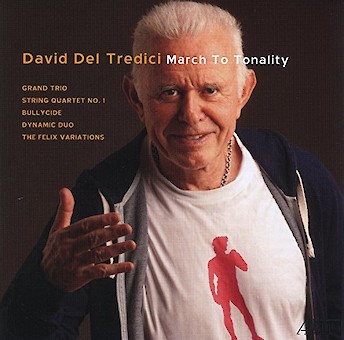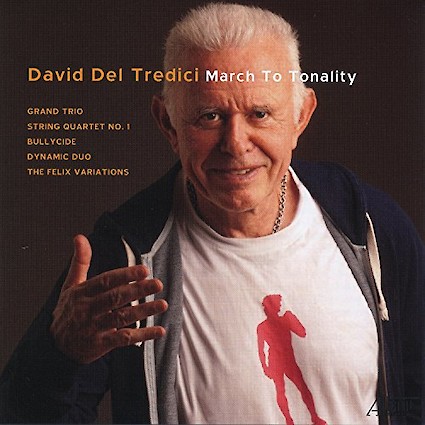Five World Premiere Recordings to be issued on Albany Records
10/2/2017
for string quartet
I waited a very long time to write this – my first string quartet. After years of composing orchestral music with many voices, elaborate textures and complex layerings, I found writing music for only four strings a release – a joy – a holiday.
The quartet, about 30 minutes long, has the traditional three movements, but their proportions are anything but classical: The final movement, Grosse Tarantella, is by itself almost 20 minutes long. These asymmetrical proportions, however, were inspired by a classical composer (Beethoven) in his least classical work (the Op. 130 string quartet with the Grosse Fuge as its finale). Beethoven’s huge fugue, following (as it does) five shorter movements, seems almost to obliterate them, as lovely and varied though they be. The finale then becomes the unquestioned emotional peak of the work as well as the longest, loudest, most developed movement – by far.
So it is, in the structure of my own quartet: The 20-minute Grosse Tarantella dwarfs its two preceding shorter movements, Experience (Prelude and Fugue) and Innocence (Intermezzo) .
Experience
A somber prelude that turns tender, then chastely joyful, yields to a fugue built on a descending modal scale in a moderate tempo. The fugue, though relaxed, eventually turns passionate, culminating in two dramatic unison notes, B and then C. A transition section follows, where the Intermezzo theme-to-be is suggested and then coupled with a (by now) familiar scalar fugue theme.
Innocence
In a moderate tempo, Innocence is an intensely romantic, though delicate, movement. Rubato is everywhere in evidence. At the end, the music seems to flower in a cascade of arpeggios and harmonics both above and below a viola solo.
Grosse Tarantella
The movement begins vivace, as a perpetuum mobile of triplet repeated notes and arpeggios, growing increasingly frantic. (According to popular Italian legend, the dance was believed to be the only cure for the poisonous bite of the tarantula spider – so quick stepping was a must!)
The motion breaks a bit, with a more chordal second theme (though the agitation lingers in the background). Eventually, the motion slackens. A “lazy” version of the first theme precipitates a full recapitulation, … a development of the two themes together, … and at length a huge cadence slowing motion to a virtual standstill.
A ghostly, muted third theme appears in three-part canon – the fourth voice continuing, as if from afar, the triplet tarantella idée fixe. When this disappears, what begins as another recapitulation turns into a dramatic, extended coda, bringing earlier material to its most frenzied pitch before it disintegrates little by little into silence...
... whence emerges the tranquil, celestial Epilogue.
Has our spider-bitten dancer ascended to the pearly gates? -- or is it simply exhaustion? Only at the very end (sul ponticello) does an apparition of the opening theme appear.
March to Tonality presents a David Del Tredici with whom listeners may be less familiar. Rather than the action-packed vocal and large ensemble music that is his calling card, this collection of chamber works, all recorded for the first time, showcase Del Tredici’s dense, dramatic writing for chamber forces.
The double-album opens with Del Tredici’s Grand Trio. The rippling energy of the opening figure from pianist Steven Beck sets the pace for the first three movements, which are all played attacca. Throughout this thirty minute climb, Del Tredici recontextualizes several familiar musical fixtures in their synthesis. As the work unfolds, moments reminiscent of Mozart, Mahler, and Mingus flow together elegantly, building towards the dramatic climax of the work, which (of course) is a fugue. The work closes with its shortest movement, Reminiscence – Allegretto amabile. Aptly titled, this movement looks back on the the rest of the work with a nostalgic, rose-tinted filter.
String Quartet No. 1 occupies the final three tracks of the first album. Innocence and Experiencecontain many tender moments, but the heart of this work is in the third movement, Grosse Tarantelle. This final third moment is nearly twice as long as the first two movements combined, and sustains the ecstatic energy of the opening throughout the entire movement. Even as the music slows later in the movement, one still hears vestiges of the opening figure rippling through the ensemble.
The tragic story of teen suicides inspires another of the pieces. Exactly halfway through Bullycide, the names of five young people who took their lives due to bullying are whispered. Again, in another work, an overtly emotional moment like this might betray the material that both precedes and follows it, but both Del Tredici’s pacing and the intimacy of the ensemble’s playing allow this to be the piece’s highpoint.
Not to be overlooked in the midst of the other, significantly larger, pieces on this double album, the chemistry of violinist Mark Peskanov and bass trombonist Felix Del Tredici brings this unusual combination together seamlessly in Dynamic Duo. While the Batman reference is (presumably) unintentional, it is still somewhat apt. In Del Tredici’s Dynamic Duo, the bass trombone is a clear leader, outfitted with equipment and skills to boot. Del Tredici presents a broad spectrum of possibility for this instrument through mutes and extended techniques, including singing through the instrument to create a haunting, metallic echo of the human voice.The final track, The Felix Variations, showcases Felix Del Tredici in a solo format. Initially unsure what else the bass trombone had to offer, each variation seemed to scold my lack of imagination, presenting a rich palette of colors and textures while never compromising expression for effect.
Grand, never gauche, and cunning without camp, Del Tredici toes a fine line in embracing a postmodern aesthetic without the emotional separation of irony. The constant rise in dramatic tension across the first half-hour of the Grand Trio, the disproportionate length of the finale of String Quartet No. 1, and the use of a myriad extended techniques in Dynamic Duo and The Felix Variations all prove powerfully expressive. March to Tonality is a longer play, but didn’t out stay its welcome.


